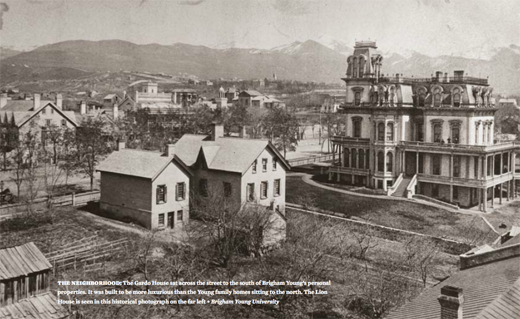
Across the street from the Beehive House, in Salt Lake City, at 70 E. South Temple, is a piece of land with a history that is far too delicious to forget. It’s all about a girl and her house.
Harriet Amelia Folsom was 22 years old and freshly arrived in the Salt Lake Valley with her parents. Her father, William Harrison Folsom, was an architect and would help design and build the Salt Lake Tabernacle; Salt Lake Theatre; St. George, Manti, and Salt Lake Temples. Brigham Young met this group of arriving Saints and it is said that when Brigham met Amelia, it was love at first site.
They married in 1863, and Amelia became Brigham Young’s 25th wife. Most of the wives agreed and accepted that Amelia was his favorite wife. She was refined, talented, and childless.

Amelia came from a cultured background. She was quick witted, brimming with intelligence, played the piano, sang, and was very good at entertaining people. Brigham usually asked Amelia to entertain those dignitaries, who would visit him.
In 1873, Pres. Young decided it would be appropriate to have a separate dwelling serve as his reception hall. He called upon Amelia’s father, as well as Joseph Ridges, to build the home. Joseph Ridges designed and built the Mormon Tabernacle Organ. The new reception hall would look very much like the organ pipes. Because Amelia would do most of the entertaining, this hall would become her residence. Brigham hoped that it would become the “Home of the Presidents of the Church” as time went on.
The home cost $80,000 and was completed in 1881. The name of the home was Gardo House. No one knows how the name came about. Some believe it came from a Spanish novel Brigham especially liked. Others believe people saw the towering home as a sentinel on guard over the valley, thus calling it Gardo. The home had a full basement, a beautiful main floor with a sweeping spiral staircase, and two upper levels; in all 46 rooms. To furnish the home, another $25,000 was spent.
Unfortunately, Brigham Young died before the home was completed. Amelia was able to live in it for a short while. Well, at least long enough for it to be inaccurately mentioned in a national publication that it was “her brothel”. The home became known as Amelia’s Palace after that. Due to legal issues with Brigham’s personal property, the home went to the Church, so Amelia had to move out. John Taylor soon moved in.
Pres. Taylor hated the home and only moved in because others insisted. He felt it was garish and opulent. Soon, it became known as Uncle John’s Mansion, assuming the idea of a “rich uncle”. Non-Mormons ridiculed the Mormon ideal of living modestly, and in humble circumstances.
Wilford Woodruff also felt uncomfortable in the home. Using it as the Church Offices, he continued to hold all Church meetings there, including the historic signing of the Manifesto, which ended polygamy.
Because of the passing of the Edmunds-Tucker Act, the government confiscated many Church properties, including the Gardo House. The government turned the house immediately over to an alcohol-treatment organization in 1892.
It passed through several owners over the subsequent years. Three mining magnates lived in the home, adding to its opulent nature. But finally it fell back into the hand of the Church, and became the home of the LDS School of Music.
In 1926, it was purchased by the Federal Reserve Bank and torn down. Today, in its place stands the Eagle Gate Plaza and Tower.
Amelia went on to marry someone else.
Information found on-line at www.historytogo.utah.gov. Search Gardo House
I just read about her and the Gardo house in one of the history books I got a the library. What a crazy house. It is kind of strange to think about Brigham Young having a favorite wife– from what I read in the other book she caused quite the stir with the other wives. It is too bad the house didn’t surive. It would be fun to see it.
There is a nice write up and pictures about the Gardo House at the following web site.
http://historytogo.utah.gov/utah_chapters/mining_and_railroads/thegardohouse.html
There is also a great video here about this awesome house!
http://youtu.be/VlWBEx0NXk0
Amelia Folsom Young was my Great, great grandfather’s daughter.
Harriet Amelia Folsom Young is my great great great grandmother s niece .